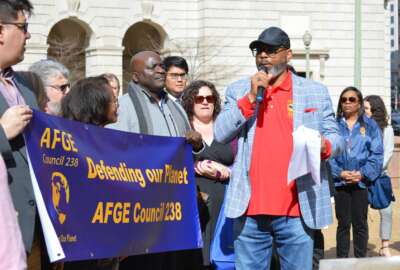
With low staffing and high workloads, EPA’s large budget proposal is a ‘catch-up game,’ administrator says
Among efforts to tackle climate change, protect public health and improve infrastructure, a top priority of the EPA budget request is rebuilding its workforce.
The Environmental Protection Agency is asking Congress for a significant boost in funding for next year, in part to try to rectify the challenge of a shrinking workforce paired with a rapidly growing workload.
The White House proposed a $12 billion budget for EPA for fiscal 2024. If enacted, the funding would be a 19% increase over the agency’s budget for fiscal 2023, and the largest budget ever for the agency.
Among efforts to tackle climate change, protect public health and improve infrastructure, a top priority of the EPA budget request is rebuilding its workforce.
Many Democrats on the Senate Environment and Public Works Committee, not surprisingly, lauded the significant boost in the Biden administration’s proposal.
“It’s no secret that EPA has not always received, at least in the last decade or so, the resources required to be successful,” Chairman Tom Carper (D-Del.) said during a March 22 committee hearing. “In recent years, flat budgets and staffing shortages have severely undermined the agency’s ability to do its job in many respects. As EPA’s responsibilities and workload continues to grow in the face of climate change and other human-caused environmental disasters, it should come as no surprise that the agency is overburdened.”
The largest EPA budget was about $10.3 billion in fiscal 2010. For fiscal 2023, EPA received an enacted budget of about $10.1 billion, the second-largest the agency has had.
The now $12 billion budget request was met with skepticism from Republican committee members. The lawmakers said the agency already received billions of dollars of additional investments through the Inflation Reduction Act (IRA), as well as the Infrastructure Investment and Jobs Act, commonly called the Bipartisan Infrastructure Law (BIL).
The IRA gave EPA about $3 billion for a new Environmental and Climate Justice Program. Under the BIL, EPA will get about $55 billion in additional funding for grants over the next five years.
“The EPA is sitting on more money than it has had in its history,” Committee Ranking Member Shelley Moore Capito (R-W.Va.) said during the hearing.
But proponents of the budget request said the additional work from the IRA and BIL make it all the more important for EPA to receive more funding.
“For years, we’ve asked EPA to do more with less — much less,” Carper said.
EPA Administrator Michael Regan, a witness at the EPA budget request hearing, said the budget request is also significant because EPA’s mission encompasses broader objectives than what was included in the two major pieces of legislation.
“We have a lot of programs that are in need of resources that don’t fit neatly under the umbrella of IRA and BIL,” Regan said. “While the percentage seems high, the dollar amount that EPA is asking for, of an agency this size, and the scope and the magnitude of our responsibility, is a catch-up game. We’ve been in decline for decades — not just one or two administrations — for decades. We’re trying to develop a workforce that can keep pace with a very challenging and growing economy.”
Union leaders said that despite the increasing workload for EPA, staff levels are significantly lower than they were in the 1990s. The American Federation of Government Employees, as well as some EPA workers, said low staffing levels are causing burnout, low morale and staff attrition.
EPA had a relatively steady workforce level through the 1990s and early 2000s, up until around 2012, when the agency saw a significant drop in its workforce size. To try to improve workforce challenges, the Biden administration’s budget request for EPA includes funding to add about 2,000 employees to the staff, for a total of 17,077 full-time employees (FTEs). The proposal would bring EPA closer to, but not completely matching, its all-time high for staffing from 1999.
EPA’s fiscal 2024 budget request justification acknowledges the disparity.
“This FTE level remains below EPA’s workforce for much of the 1990s and early 2000s, while today the agency faces a growing workload and set of statutory responsibilities.”
AFGE welcomed the large budget proposal, saying that it would especially help agency employees who are often overworked within understaffed offices. But the union said it also depends on the types of positions.
“We applaud the increased staffing designated by the President in his budget, but also call on Congress to provide specific appropriation incentives to retain EPA scientists and engineers,” Marie Owens Powell, president of AFGE Council 238, which represents EPA employees, said in a statement. “Providing more pay and allowing EPA professionals to work in communities throughout the nation will protect more people and maintain the most capable environmental workforce ever assembled.”
Capito, though, also raised concerns with EPA’s telework and return-to-office policies. She said a clearer picture of return-to-office plans is necessary before considering the large funding influx.
“We need to do this before we seriously consider any more administrative outlays, including the EPA’s desire to hire approximately 2,000 additional FTEs,” Capito said.
Currently, most of EPA’s employees are on a hybrid work schedule, Regan said, working a mix of both remote and in-office. That schedule is unlikely to change anytime soon — the budget request emphasized an EPA workforce that is “increasingly hybrid.”
“We are definitely meeting all of our performance targets [and] our staff is fully engaged,” Regan said.
EPA said it will continue tinkering with its physical office footprint, according to the budget request. The agency said it will consider “the potential for releasing underutilized space or sharing with other federal agencies, investing in facility enhancements to assess utilization and inform future consolidations or releases, and converting workspaces to support hoteling and hybrid collaboration.”
But agencies are in general still unsure of their long-term office space needs, leading to their reluctance to give up physical office spaces.
“I think what we’re trying to do is do what everyone else is doing, which is think about, ‘how do we have a responsible policy in place that leverages our workforce?’” Regan said. “Whether you’re in corporate America, state government or the federal government, people have hybrid working conditions, and we’re trying to be sure that we’re accommodating that schedule while meeting our mission.”
On top of simply hiring more staff, EPA said it plans to incorporate diversity, equity, inclusion and accessibility into its hiring practices, as well as expand the EPA internship program, including paid internship positions.
The proposal would also add funding for the human resources office, EPA said. The agency is asking for $79.8 million for its HR office for fiscal 2024 — an increase of $21.1 million over the enacted 2023 budget of $58.7 million.
Regan said that although it seems like a significant increase, the funding is necessary for helping the agency’s staff as a whole.
“The percentage increase that we received last year was the first step,” Regan said. “This year, I know 19% sounds like a lot. But when you look at the dollar amount, and the needs of the agency, it’s not.”
Copyright © 2025 Federal News Network. All rights reserved. This website is not intended for users located within the European Economic Area.
Drew Friedman is a workforce, pay and benefits reporter for Federal News Network.
Follow @dfriedmanWFED
Related Stories





